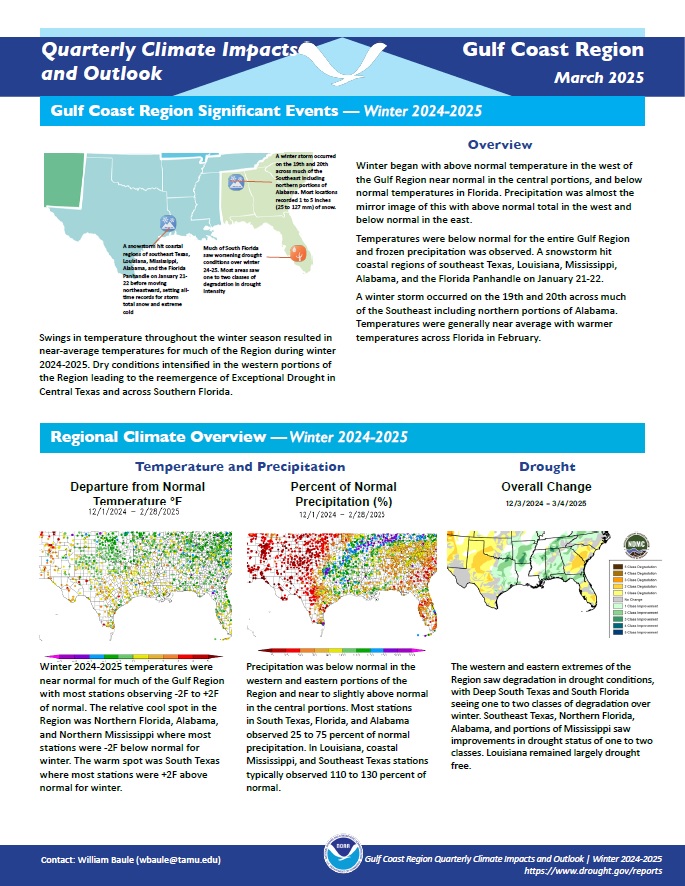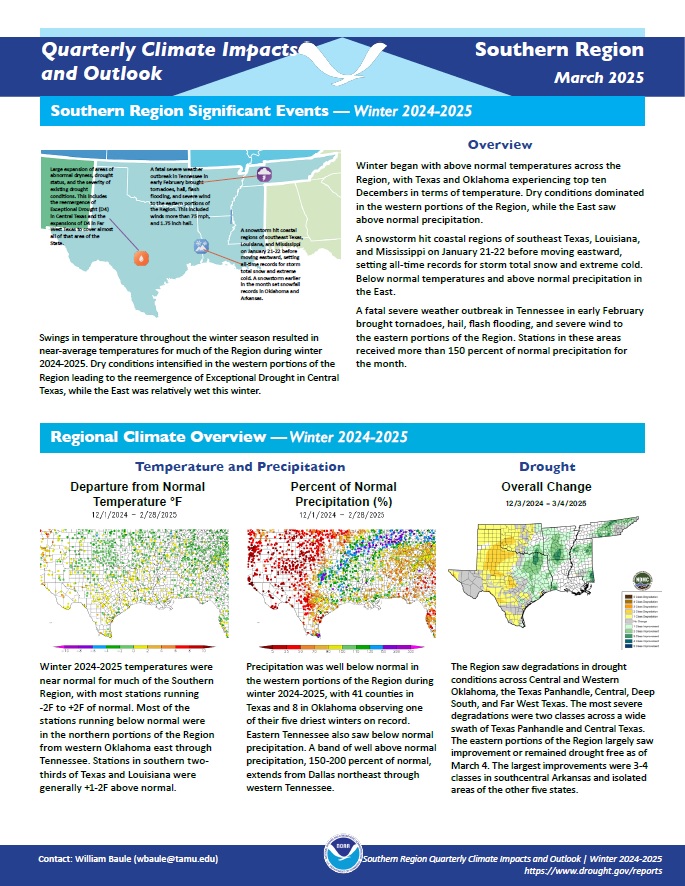Quarterly Climate Impacts and Outlook for the Mid-Atlantic Region for December 2024–February 2025. Dated March 2025.
The purpose of the Pacific Northwest Water Year 2024 Impacts Assessment is to connect the water year conditions to sector-specific impacts to inform planning, response actions, and technical and scientific information needs. Ultimately, the assessment can be used as a resource for future management of drought and other climate extremes.
Quarterly Climate Impacts and Outlook for the Gulf Coast Region for December 2024–February 2025. Dated March 2025.
Winter 2024-2025 temperatures were near normal for much of the Gulf Region, with most stations observing temperatures 2°F below normal to 2°F above normal. Precipitation was below normal in the western and eastern portions of the region and near to slightly above normal in the central portions.
Quarterly Climate Impacts and Outlook for the Southern Region for December 2024–February 2025. Dated March 2025.
Winter 2024-2025 temperatures were near normal for much of the Southern Region, with most stations running 2°F below normal to 2°F above normal. Precipitation was well below normal in the western portions of the region, with 41 counties in Texas and 8 in Oklahoma observing one of their five driest winters on record.
Quarterly Climate Impacts and Outlook for the Southeast and Caribbean Region for December 2024–February 2025. Dated March 2025. (Updated April 2025 to add Spanish translation of Caribbean information.)
Quarterly Climate Impacts and Outlook for the Missouri River Basin for December 2024–February 2025. Dated March 2025.
Despite a warm start, temperatures this winter were mostly below normal. This winter was dry, with snowfall well below normal across much of the northern and central Plains.
Quarterly Climate Impacts and Outlook for the Western Region for December 2024–February 2025. Dated March 2025.
Winter temperatures were above normal across the Southwest with California and Arizona both ranking as the fourth warmest on record. Temperatures were closer to normal in the Pacific Northwest and northern Rockies with some areas of below-normal temperatures in Montana. Winter precipitation was much below normal across the Southwest. Much of Oregon, eastern Washington, southern Idaho, and Montana saw above-normal winter precipitation.
Quarterly Climate Impacts and Outlook for the Midwest Region for December 2024–February 2025. Dated March 2025.
Winter season temperatures were near normal in the north and slightly below normal across the south. Winter season precipitation was above normal across the Ohio River Valley and the far upper Midwest and below normal elsewhere. This seasonal pattern of wetness and dryness was largely similar in December, January, and February across the region.
Quarterly Climate Impacts and Outlook for the Great Lakes Region for December 2024–February 2025. Dated March 2025.
Winter temperatures ranged from 4°F (2°C) colder than normal to 4°F (2°C) warmer than normal. Winter precipitation was near average for all basins, with the overall basin at 99% of average.
Quarterly Climate Impacts and Outlook for Alaska and Northwestern Canada for December 2024–February 2025, with an outlook for April–June 2025. Dated March 2025.
ECCC, NOAA, and partners created these outlooks to inform the public about recent impacts within their respective regions. Each regional report contains easy-to-understand language, and anyone can access them through the U.S. Drought Portal.











